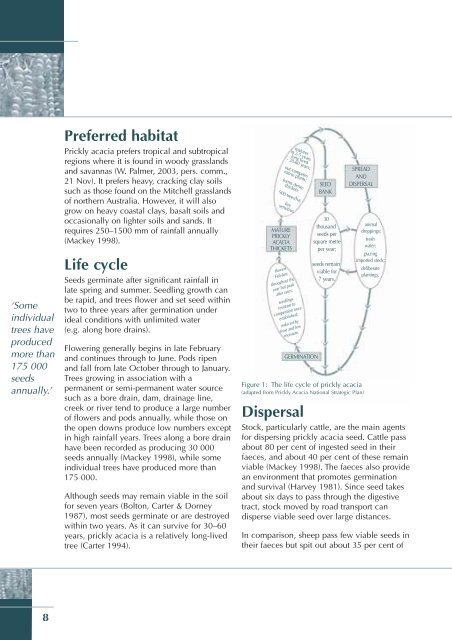Section 1: Prickly acacia—ecology and threat - Weeds Australia
Section 1: Prickly acacia—ecology and threat - Weeds Australia
Section 1: Prickly acacia—ecology and threat - Weeds Australia
Create successful ePaper yourself
Turn your PDF publications into a flip-book with our unique Google optimized e-Paper software.
‘Some<br />
individual<br />
trees have<br />
produced<br />
more than<br />
175 000<br />
seeds<br />
annually.’<br />
8<br />
Preferred habitat<br />
<strong>Prickly</strong> acacia prefers tropical <strong>and</strong> subtropical<br />
regions where it is found in woody grassl<strong>and</strong>s<br />
<strong>and</strong> savannas (W. Palmer, 2003, pers. comm.,<br />
21 Nov). It prefers heavy, cracking clay soils<br />
such as those found on the Mitchell grassl<strong>and</strong>s<br />
of northern <strong>Australia</strong>. However, it will also<br />
grow on heavy coastal clays, basalt soils <strong>and</strong><br />
occasionally on lighter soils <strong>and</strong> s<strong>and</strong>s. It<br />
requires 250–1500 mm of rainfall annually<br />
(Mackey 1998).<br />
Life cycle<br />
Seeds germinate after significant rainfall in<br />
late spring <strong>and</strong> summer. Seedling growth can<br />
be rapid, <strong>and</strong> trees flower <strong>and</strong> set seed within<br />
two to three years after germination under<br />
ideal conditions with unlimited water<br />
(e.g. along bore drains).<br />
Flowering generally begins in late February<br />
<strong>and</strong> continues through to June. Pods ripen<br />
<strong>and</strong> fall from late October through to January.<br />
Trees growing in association with a<br />
permanent or semi-permanent water source<br />
such as a bore drain, dam, drainage line,<br />
creek or river tend to produce a large number<br />
of flowers <strong>and</strong> pods annually, while those on<br />
the open downs produce low numbers except<br />
in high rainfall years. Trees along a bore drain<br />
have been recorded as producing 30 000<br />
seeds annually (Mackey 1998), while some<br />
individual trees have produced more than<br />
175 000.<br />
Although seeds may remain viable in the soil<br />
for seven years (Bolton, Carter & Dorney<br />
1987), most seeds germinate or are destroyed<br />
within two years. As it can survive for 30–60<br />
years, prickly acacia is a relatively long-lived<br />
tree (Carter 1994).<br />
matures<br />
in 2-5 years<br />
long lived<br />
- 30-60 years;<br />
out-competes<br />
native plants;<br />
forms dense<br />
thickets;<br />
900 trees/ha;<br />
fire<br />
sensitive.<br />
MATURE<br />
PRICKLY<br />
ACACIA<br />
THICKETS<br />
flowers<br />
Feb-Jun;<br />
throughout the<br />
year but peak<br />
after rains;<br />
seedlings<br />
resistant to<br />
competition once<br />
established;<br />
reduced by<br />
frost <strong>and</strong> low<br />
moisture.<br />
GERMINATION<br />
SEED<br />
BANK<br />
30<br />
thous<strong>and</strong><br />
seeds per<br />
square metre<br />
per year;<br />
seeds remain<br />
viable for<br />
7 years.<br />
SPREAD<br />
AND<br />
DISPERSAL<br />
Figure 1: The life cycle of prickly acacia<br />
(adapted from <strong>Prickly</strong> Acacia National Strategic Plan)<br />
animal<br />
droppings;<br />
fresh<br />
water;<br />
grazing<br />
imported stock;<br />
deliberate<br />
plantings.<br />
Dispersal<br />
Stock, particularly cattle, are the main agents<br />
for dispersing prickly acacia seed. Cattle pass<br />
about 80 per cent of ingested seed in their<br />
faeces, <strong>and</strong> about 40 per cent of these remain<br />
viable (Mackey 1998). The faeces also provide<br />
an environment that promotes germination<br />
<strong>and</strong> survival (Harvey 1981). Since seed takes<br />
about six days to pass through the digestive<br />
tract, stock moved by road transport can<br />
disperse viable seed over large distances.<br />
In comparison, sheep pass few viable seeds in<br />
their faeces but spit out about 35 per cent of

















